
Mediterranean Garden Society

Mediterranean Garden Society
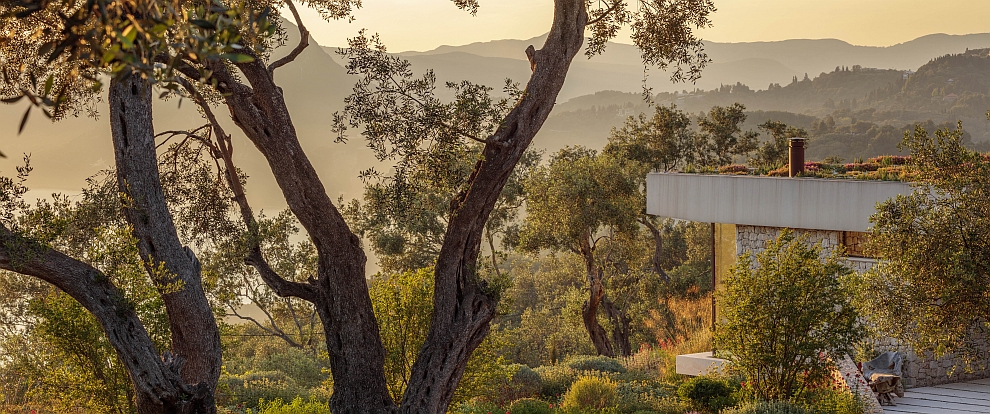
Designing for the Mediterranean Climate
This is a summary of key points and a plant list from a recent webinar by Jennifer Gay for MGS members.
Photographs to illustrate the article published in The Mediterranean Garden No. 120, April 2025
The photo at the top of this page shows Sinarades, Corfu, with Coronilla glauca in flower (photo Jennifer Gay)
The mediterranean climate offers a wealth of plant opportunities for beauty and biodiversity. Thoughtful design, planning and practice help us to create gardens that survive long, hot, dry summers while taking advantage of mild wet winters.
Creating a garden that is compatible with the environmental conditions helps achieve long-term sustainability and resilience. I’ve loved working with Mediterranean landscapes since the late ‘90s and along the way have learnt from others, from experience, my mistakes and all that the soil, rocks, plants and weather have taught me, prompting constant refining of ideas in pursuit of enduring gardens.
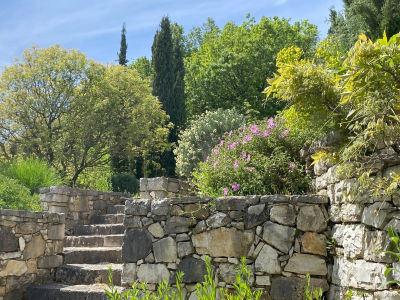
Agnos House, Corfu with Cupressus sempervirens, Pistacia terebinthus,
Wisteria sinensis, Cistus creticus, Anthyllis barba-jovis, Miscanthus sinensis
Core elements
Mediterranean zones face challenges with the changing climate - our long, dry summers are potentially getting longer and hotter, while there are ever-increasing demands on water resources, resulting in a dwindling supply of groundwater and rising saltwater intrusion. We need to use plants naturally adapted to withstand drought, and for our gardening practices to reduce, or better still eliminate, plants’ dependence on irrigation while enhancing biodiversity and soil health.
Key approaches include:
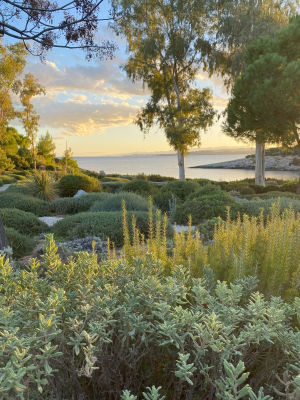
Ermioni showing Cistus x pulverulentus in foreground with Rosmarinus 'Sappho'
Sense of place/locality
Honour the genus loci, that intangible quality of place, both spiritually and materially.
Choosing plants that grow in the surrounding landscape and local materials such as gravel, stone or sustainably sourced timber creates a sense of belonging and reduces the environmental impact of transportation.
Sustainable maintenance practices
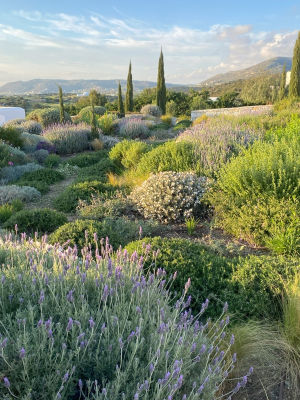
Naxos, Lavandula dentata 'candicans' in flower and Cistus x pauranthus 'Natache')
The future of mediterranean gardening
Growing climate-appropriate, resilient plants will help gardens cope with increasingly unpredictable weather, for example longer droughts and torrential rain, while relieving pressure on natural resources such as water and at the same time improving biodiversity. Gardeners collectively manage a considerable amount of land and our gardening habits can contribute significantly to global environmental stewardship.
A few plant ideas for mediterranean gardens
The list below includes some of the plants I use frequently for reliable and resilient establishment in mediterranean conditions.

Karlovassi, Samos with Cypress trees
Trees, evergreen
Ceratonia siliqua (carob) - Mediterranean, Middle East
Cupressus sempervirens (Italian cypress) - Eastern Mediterranean, Iran
Pistacia terebinthus (terebinth/turpentine tree) - Mediterranean
Olea europaea (olive) - Mediterranean
Quercus ilex (holm oak) - Mediterranean
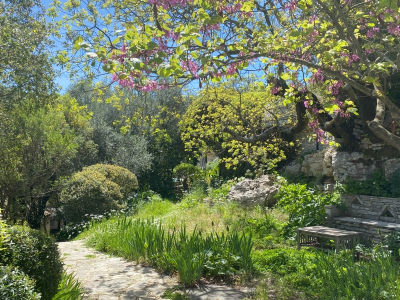
Rou Corfu with Cercis siliquastrum, Pistacia terebinthus, clipped Quercus coccifera
Trees for flowers or fruit
Cercis siliquastrum (Judas tree) - Mediterranean, Western Asia
Lagunaria patersonii (Norfolk Island Hibiscus) - Australia, Norfolk Island
Melia azedarach (chinaberry, Persian Lilac) - South and South-east Asia, Australia
Morus nigra (black mulberry) - Western Asia, Iran
Punica granatum (pomegranate) - Iran to India
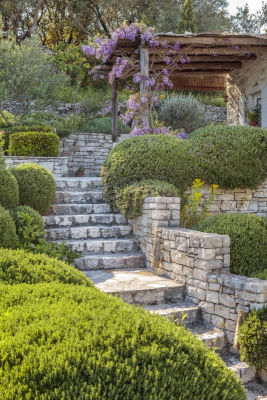
Ithica House, Corfu including Rosmarinus 'Boule', Teucrium fruticans,
Wisteria sinensis, Olea europeae, Euphorbia ceratocarpa
Climbers for scent or flowers
Clematis cirrhosa (winter-flowering clematis) - Mediterranean
Jasminum officinale (common jasmine) - Iran, Himalayas
Lonicera etrusca (Etruscan honeysuckle) - Mediterranean, Western Asia, North Africa
Podranea ricasoliana (pink trumpet vine) - South Africa
Trachelospermum jasminoides (star jasmine, evergreen jasmine) - East Asia
Wisteria sinensis (Chinese wisteria) - China
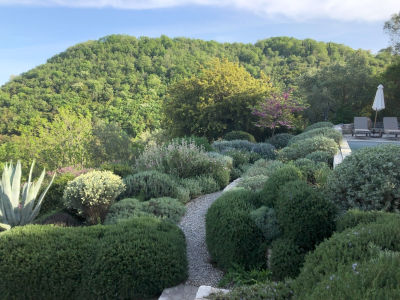
Ithica House, Corfu including Quercus ilex, Cercis siliquastrum, Phlomis purpurea
Shrubs, evergreen ‘backbone’
Anthyllis barba-jovis (Jupiter’s beard) - Mediterranean
Arbutus unedo, Arbutus unedo var. rubra, Arbutus ‘Marina’ (strawberry tree) - Mediterranean
Atriplex halimus (saltbush) - Mediterranean
Cneorum tricoccon (spurge olive) - Western Mediterranean
Elaeagnus × submacrophylla (oleaster, silverberry) - hybrid, origins uncertain
Laurus nobilis (bay, laurel) - Mediterranean
Myrtus communis (myrtle) - Mediterranean. Notable cultivars: ‘La Clape Blanc’, ‘Guilli’
Phillyrea angustifolia (narrow-leaved mock privet) - Mediterranean
Pistacia lentiscus (lentisk, mastic tree) - Mediterranean
Rhamnus alaternus (Mediterranean buckthorn) - Mediterranean
Teucrium fruticans (shrubby germander) - Mediterranean
Viburnum tinus (laurustinus) - Mediterranean
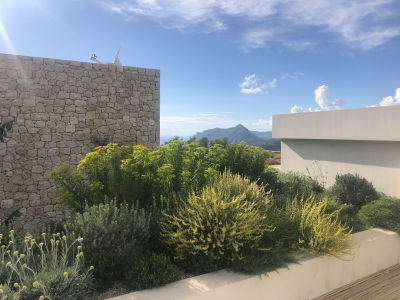
Roof garden Sinarades, Corfu with Anthyllis cytisoides, Euphorbia ceratocarpa
in flower plus Cneorum tricoccon, Dorycnium pentaphyllum
Shrubs, flowering in late spring or summer
Abelia × grandiflora (glossy abelia) - hybrid (China, Mexico origins)
Bupleurum fruticosum (shrubby hare’s ear) - Mediterranean
Ebenus cretica (Cretan ebenus, shrubby sainfoin) - Crete
Leucophyllum frutescens, Leucophyllum langmaniae (Texas Sage, cenizo) - South-western U.S., Mexico
Vitex agnus-castus (chaste tree) - Mediterranean, Asia
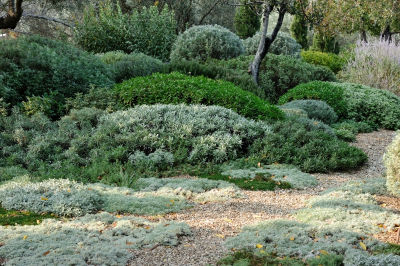
Keratea, Attica including Lomelosia minoana, Bupleurum fruticosum,
Helichrysum orientalis, Ballota pseudodictamnus
Sub-shrubs
Cistus × pauranthus ‘Natacha’ (rockrose) - Mediterranean
Cistus × skanbergii (pink rockrose - Mediterranean
Cistus × tardiflorens (late-flowering rockrose) - Mediterranean
Pseudodictamnus mediterraneus (syn. Ballota pseudodictamnus)(false dittany) - Mediterranean
Centaurea spinosa (spiny knapweed) - Mediterranean
Lotus dorycnium (syn. Dorycnium pentaphyllum)(prostrate Canary clover) ) - Mediterranean
Euphorbia ceratocarpa, Euphorbia dendroides, Euphorbia rigida (spurge species) - Mediterranean
Helichrysum italicum (curry plant) - Mediterranean
Globularia alypum ‘La Durance’(blue globularia) - Mediterranean
Lavandula dentata var. candicans, Lavandula × heterophylla ‘African Pride’, Lavandula × ginginsii ‘Goodwin Creek Grey’, Lavandula × intermedia ‘Super’ (lavender hybrids/cultivars) - Mediterranean
Lomelosia minoana (Minoan scabious) - Crete
Origanum dictamnus, Origanum syriacum (Cretan dittany, Syrian oregano) - Crete and the Middle East respectively
Phlomis chrysophylla, Phlomis × cytherea, Phlomis ‘Marina’ (Jerusalem Sage species/cultivars) - Mediterranean
Ptilostemon chamaepeuce (shrubby knapweed) - Crete
Rosmarinus ‘Île de Beauté’, Rosmarinus ‘Sappho’(rosemary species/cultivars) - Mediterranean
Satureja thymbra (winter savory) - Mediterranean
Teucrium marum (cat thyme) - Western Mediterranean
Thymus saturejoides (thyme species) - North Africa
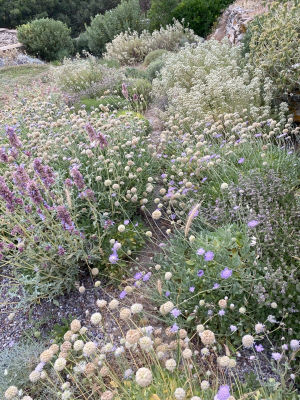
Aprovato, Andros including Lomelosia cretica, Origanum 'Clara', Satureja thrymba
Perennials and grasses
Erigeron karvinskianus (fleabane) - Mexico, Central America
Oenothera lindheimeri (syn. Gaura lindheimeri)‘Whirling Butterflies’ (Lindheimer’s beeblossom) - Southern U.S., Mexico
Miscanthus sinensis ‘Yaku Jima’ (Chinese silver grass) - East Asia
Salvia ‘Blue Spire’ (syn. Perovskia ‘Blue Spire’) (Russian Sage) - hybrid, origins in Central Asia
Salvia leucophylla ‘Figueroa’(purple sage) - California
Stipa calamagrostis (Feather Grass) - Europe, Asia.
You can watch the Jennifer Gay webinar in full and all past webinars on the Mediterranean Garden Society channel here.
THE MEDITERRANEAN GARDEN is the registered trademark of The Mediterranean Garden Society in the European Union, Australia, and the United States of America
website designed and maintained
by Hereford Web Design